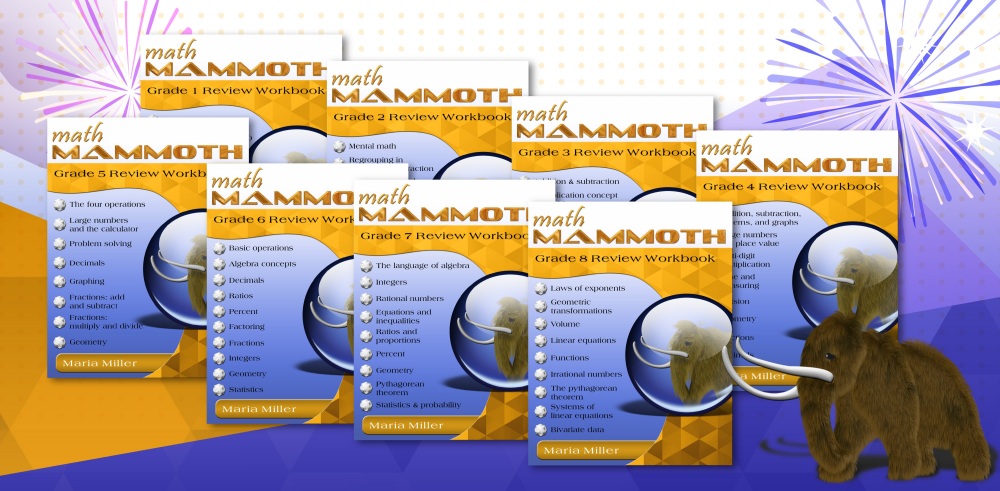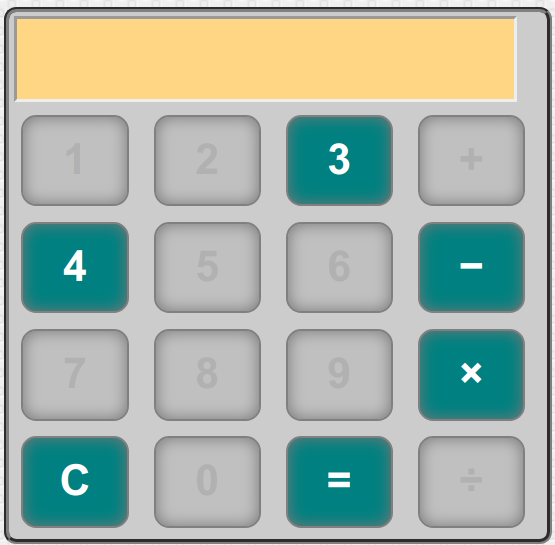
Hello again! In this month's newsletter we have: |
1. Math Mammoth newsSALE at the Math Mammoth website for the digital versions!Get ALL the digital downloads at 25% off! Use coupon code PQ7E-QRK5-6EBN at checkout. The promotion will last through May 26, 2025. Some have asked... Rainbow Resource Center will probably run a sale for the MM printed books in May or June, based on how they've done in the past. I emailed them a few days ago and have not heard back, so unfortunately, I don't have any specific info. The new edition for grade 7 is coming soon! Later this month! |
2. How to help a child with dysgraphia to do math The good point is, doing math in one's head does gives the child the advantage of having a good number sense! But we need to balance it with the fact that it is also important to learn to communicate with others. That is what writing answers down is all about... being able to explain and communicate to others your work and how you did it. For starters, grid paper or graph paper can be a real game changer for such children. Consider using paper with bigger squares than the standard size — it really helps keep numbers lined up for calculations done in columns and long division. You can turn lined paper so its lines are vertical as another option for graph paper. Another tip is to use a different colored highlighter in each column. Communicating one's thought process can also be accomplished orally. Basically, I suggest to allow the child to do a portion of the work in their head, but request that for some problems, they explain in detail to you HOW they did it. Especially word problems! Also, for a portion of the problems, I'd like for the child to strive to do the writing. For example, let's say it's fraction problems of some kind, and not the easiest problems but such that require an intermediate step. Perhaps the child could do the intermediate step in their head, but I suggest you require the child to show you their work on paper for at least 1-2 problems (even if the writing is slow and with errors). But don't punish the child for writing errors. A few other tips and ideas:
Coming back to the child who insists doing a lot of work in their head. Something to keep in mind is that one other goal in math is accuracy... to learn to check one's work and not just "hand it over" as it is the second it is finished. This principle applies in other aspects of life, too, to be critical of one's own work and try to find ways to check it, go over it again, etc. Such as when you're starting to drive somewhere: check that there's gas, check mirrors, etc. Or if you're shopping, you might double-check your shopping list before you go to the cashier. Just a basic principle. Encourage your child/student to check their own work, such as subtractions by adding, additions by adding in a different order, long divisions by multiplying — or even with a calculator, depending on the situation. Perhaps even add an incentive towards that goal. These are just some thoughts about this topic... if you have more ideas, please reply to this email and let me know! Once again, I plan to publish these tips on my site. |
3. Worksheets for extra practiceDid you know that Math Mammoth curriculum comes with a handy worksheet maker?See a preview of how it looks like, for various grade levels:
Grade 1 worksheet generator preview For the digital version, you will find it in the folder titled "For review". For the print version, there is a link to it in the tests & cumulative reviews book, just before the cumulative reviews. When you notice your student needs more practice in some particular topic, check the worksheet generator! It covers dozens and dozens of topics for each grade! What is more, if you notice it lacks a particular type of calculation, we can probably add that type of worksheet to the generator fairly quickly — just let me know. We recently did that for the topic of finding a fractional part of a whole (e.g. find 2/5 of 45) for grade 4, upon someone's request. Here's an example worksheet that we recently added to 7th grade: Equations with fractions (this link actually makes a worksheet). |
4. Review workbooksMath Mammoth review workbooks are intended to give students a thorough review of their particular grade level of math, following the main areas of math for each grade. Each book has both topical as well as mixed (spiral) review worksheets, and includes both per-topic tests and a comprehensive end-of-the-year test. (The tests can also be used as review worksheets, instead of tests.) It won't matter if you use some other math curriculum; these workbooks are great for extra practice, to prepare students for the next grade, or for summer math. Please note: The CONTENT for these workbooks is taken from the corresponding level of the Math Mammoth curriculum (the mixed reviews, reviews, tests, and cumulative reviews). Therefore, these workbooks contain duplicate content if you already own the Math Mammoth curriculum (Light Blue Series). |
5. A broken calculator gameHere's a neat game providing a little bit of problem solving (for students in grades 3-12).Find ways to make numbers from 1-20 with the broken calculator... some keys are simply not available! |
6. Just for fun!
Thanks for reading! 🙂 Feel free to forward this issue to a friend/colleague! Subscribe here. Till next time, Maria Miller |
| Complete curriculum | Math games and interactive practice | Math Mammoth freebies | New to MM? Start here |
| Privacy & your personal data | Bodies in Heaven - What Kinds? | Blue Series: For filling in gaps |



